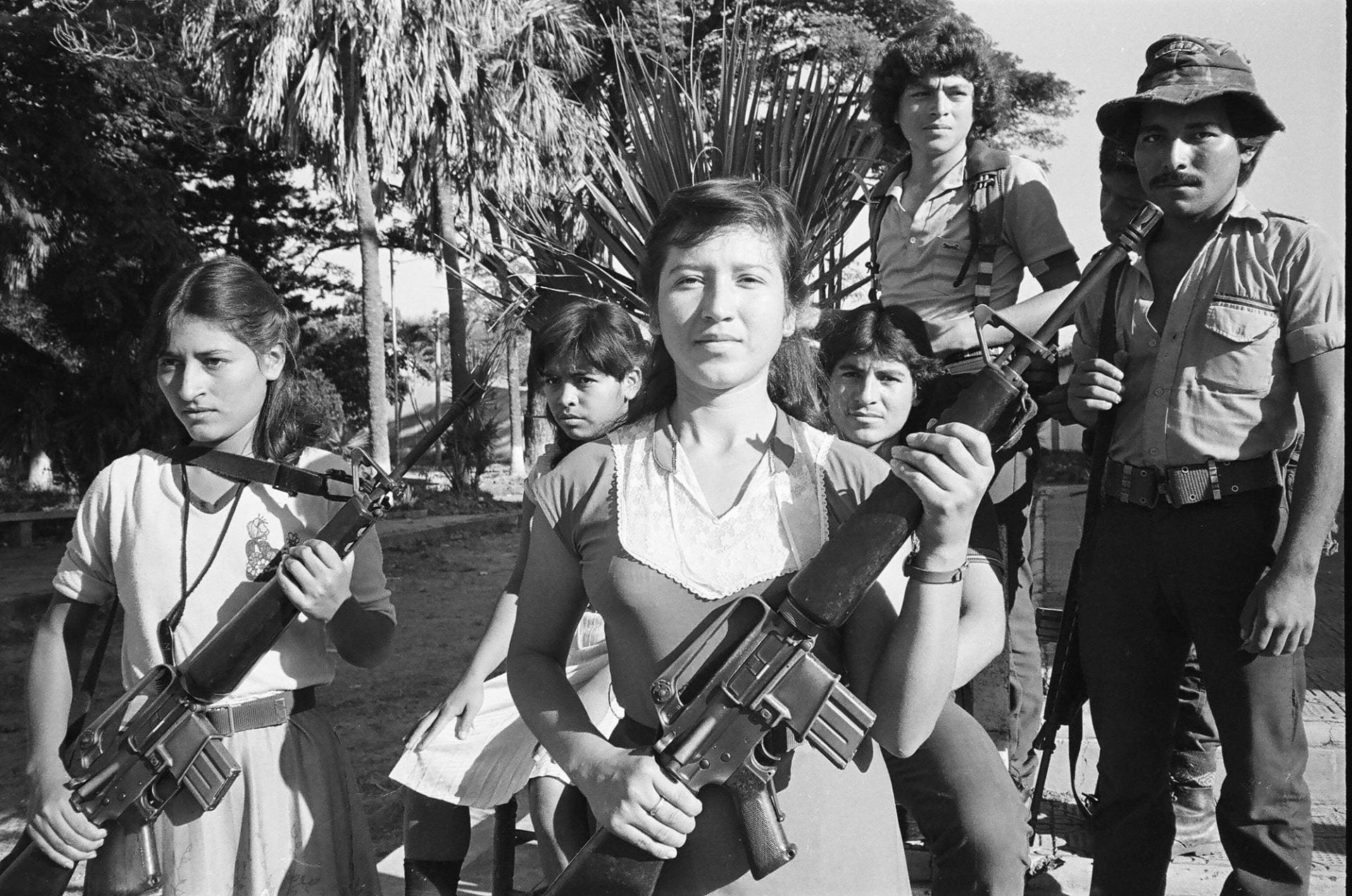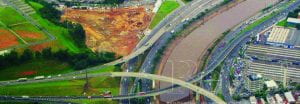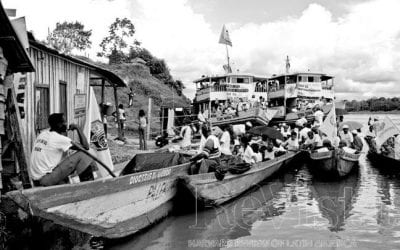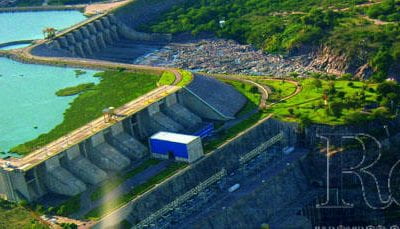Water-Friendly Cities?
Water Sustainability in Mega-cities: The Case of São Paulo, Brazil
The world just turned urban. For the first time in human history, urban citizens make up more than half the world’s population, the 2006/2007 UN-Habitat State of the World’s Cities Report tells us. In the last century, Europe and the Americas experienced intense urban growth. Today this is the reality for Asia and Africa.
A city is an entangled arrangement, a complex web of interdependent support mechanisms—transportation, water supply, power lines, housing, garbage disposal, sewers and many others, working within relatively small land areas within a very compact structure. Each overlay interacts with the environment in different ways, creating its own impact.
Water alone is a very complex subsystem. Water is needed for health, for sustaining human lives, for economic activities, for providing better living standards, for diluting and transporting waste, and last, but not least, for maintaining the aesthetic value of a beautiful landscape.
The rapid increase of the urban population has changed the way urban water systems interact with the environment. One problem is that urban domestic and industrial consumers are using more and more water and, consequently, depleting available sources. At the same time, cities tend to degrade neighboring water resources with their wastes. Yet urbanization and the consequent concentration of production are an essential part of economic development, and cities are effervescent cultural centers.
Can we deal with this dilemma and turn our cities into water-friendly places? When the size, population and activity level of an urban area increase, it becomes more and more difficult to manage its subsystems, including water. Cities must deal with complex physical systems, and the investment required to provide adequate services for a good quality of life becomes larger and larger.
The urban population has increased almost tenfold in some cities in developing countries (such as São Paulo, Mexico City, Mumbai) during the last 50 years, mostly due to migration of the rural poor to peri-urban settlements. Financial resources to provide adequate services were invested far below the required rate. Shanty areas grew apace with no water supply or sanitation. The lack of industrial waste control, along with chaotic spread and unplanned occupation, led to intense worsening of water pollution.
Urban conglomerations must develop adequate and feasible solutions. Cities face the challenges of safely providing drinking water for all of its inhabitants, reducing health risks from both pollution sources and flood events, guaranteeing adequate water sources to sustain economic activity and maintaining a pleasant environment for all. Urban sustainability depends on reducing the urban hydrological footprint by reducing water consumption and consequently the stress on water sources; by reducing externalities such as pollution exportation; and by reducing impacts from flooding.
In low-and middle-income nations the main challenge regarding water remains the provision of safe drinking water and sanitation services. The Millennium Development Goals Report 2011 stated that, in 2008, an estimated 141 million people in urban areas continued to rely on untreated water for their daily drinking. In sanitation, the situation is much worse. The millennium goal of halving the proportion of the population without access to sanitation services by 2015 will not be met. The vast majority of the people who lack good provision of services lives in slums and squatter settlements, which makes this goal even more difficult to achieve.
Flood control is another critical issue. Cities thrive in the flat areas, navigable conditions and productive environments of fluvial floodplains, where floods are part of the natural process of revitalizing aquatic biodiversity. But typical concrete urban structures are resistant to penetration by water, and in addition, soils compacted by the processes of urbanization become less absorbent themselves. It is a very well known fact that drainage blockages—known more technically as imperviousness—significantly increase flood frequency. To reduce the impact of floods, cities must become more permeable. Absorbing floodwater from the river requires “space.” But “space,” or in the terms of developers, lots and real estate, are highly valued assets in urban areas, whether they are safe from flooding or not.
This is not to imply that urban areas do not have environmental advantages, such as economies of scale due to aggregation and the potential for increasing reuse. These advantages are real, but we have not utilized them to their full extent, whereas the disadvantages of exceeding the carrying capacity of natural systems are frequently actualized.
Land use planning and control is recognized as an extremely important link between water and urban management. But how can we put it in practice when increasing land values are the reality of the chaotic megacity?
Better cities require new urban water governance. The main difficulty is the recognition that water “percolates” through several layers of the urban tissue. Housing, services, transportation, water supply, waste collection, flood control, just to name a few, are all interlocked layers. To move forward we must be capable of tackling all of them in an integrated manner.
The Metropolitan Region of São Paulo, Brazil, with its 20 million inhabitants, is a good example of this difficult task. The MRSP includes the city of São Paulo and 39 other municipalities, occupying an area of approximately 8,000 square kilometers, of which 2,000 square kilometers are highly urbanized. It is one of the largest urban concentrations and industrial complexes of Latin America. The urbanized area occupies a major part of the upper Tietê River basin. It embraces, or maybe suffocates, the river.
High population and industrial growth rate in the last fifty years created an imbalance between water supply and demand, with severe pollution problems. Furthermore, the growing imperviousness of urban soil and the unplanned occupation aggravated the flooding problems. At the beginning of the 20th century, São Paulo was a city with 300,000 inhabitants, occupying 0.6 percent of the total area of the basin. In less than one century, it transformed itself into a megalopolis of 20 million people, occupying almost half of the upper Tietê basin.
During the 20th century, the population explosion concentrated more and more people in a small area. But now, even as population growth rates diminish, a new problem has arisen. In spite of the diminishing population growth rates, the area occupied by the city is now expanding at a higher pace. New residential developments for the growing middle class are difficult to control. For water managers, this translates to more impervious surfaces and insufficient infrastructure.
As a São Paulo native, I would like to see my city be a water-friendly place. To reach that paradigm, the city would need to improve a sustainable, safe-drinking supply system, as well as the water quality of its rivers, and to reduce the impact of flooding.
The Metropolitan Region of São Paulo utilizes more than 70 cubic meters per second of drinking water to supply its 20 million people. To put water in each tap, the water supply utility operates three large production systems, plus 8 drinking water treatment plants, 1,112 Km of water-mains, 373 distribution reservoirs and 30,000 Km of distribution lines.
The largest production system is the Cantareira System, located 80 Km north of the region in a neighboring watershed. The second largest is the Guarapiranga-Billings Reservoir system, located within the watershed and on the edge of the urban area. Low-income families started to settle near these water sources some decades ago. The population has exploded to 1.5 million people living very close to, and impacting, the sources. The third system consists of the headwaters of the Tietê River, but again city expansion is threatening its water quality. Currently, the cost to produce 1,000 cubic meters of drinking water is US$18 from the Guarapiranga system, US$11 from the Alto Tietê system, and US$3 from the Cantareira system. This disparity in numbers is the cost of pollution and lack of protection of the supply systems.
Securing the water supply system of São Paulo for the future requires that several tasks be accomplished at the same time, such as land use planning and control to protect the water sources and control urban sprawl. In a region where 10 percent of the population lives in inadequate housing conditions, this is not an easy task. It is now well recognized that providing adequate housing for the poor is an essential step to clean water sources.
The current water supply systems are being fully used and do not support further population growth or an increase in demand. Hence the MRSP needs wise management of existing resources and significant investment in case of more growth or greater demand. Good water management requires the concurrent action of the water utility and the set of all 39 municipalities of the MRSP, plus significant investments. Looking for new sources is becoming more and more difficult. To add a mere 7 percent in drinking water production, the water utility will spend almost two billion dollars. Demand must be managed.
To control pollution, São Paulo has been investing heavily for the last 20 years in collection and wastewater treatment services. More than two billion dollars have already been spent and the program will probably continue for ten more years, doubling this investment. Currently 86 percent of the population is serviced with collection services and 66 percent of the collected sewage is treated.
Even after the completion of the program, though, we will need further action to restore water quality to the lifeless rivers. The city urgently needs more efficiency in sewage collection, better control of solid waste disposal and the multipart effort of the many government agencies and utilities involved in this process. We hope we will have the river back at least for the benefit of the urban landscape.
Flooding remains a problem for the city and for quality of life. Emerging regulations to control occupation along the rivers and to create green spaces and linear parks are changing the looks of former degraded areas. New planning, structures to delay flows, maintaining the river courses as natural as possible, are the new order for a city that strives for a greener future.
Billions have already been invested. Much more money is still needed. The path the city is taking with respect to pollution is already giving us hope to live in a more water-friendly city in the future. But developing a clear vision of the city’s many-layered relationship with water, alongside improving managerial capacity, remain just as important as investment. Although difficulties remain, the current path is already giving us hope that we may live in a more water-friendly city in the future.
Monica Porto is Professor of Environmental Engineering at the University of São Paulo.
Related Articles
Al Son Del Río
English + Español
Wending our way down the Atrato River in Colombia’s Chocó region, we finally reach the town of Puné. It is a fickle June afternoon, one of those humid tropical afternoons when the sun and water alternate in sudden torrential rains. “The river is everything to us,” …
Water: The Last Word
A man was shot and killed in a dispute in June 2010 over a water connection in San Juan Cancuc, Chiapas, Mexico. A Zapatista settlement coexists, if uneasily, on the edge of the municipality. Residents of the nearby community of El Pozo had threatened to shut off Zapatistas water connection. A confrontation ensued, shots followed, with one fatality and nine wounded. …
Water, The Energy Sector and Climate Change in Brazil
As a Brazilian, I am very proud of the rich natural resources of my country, in particular water resources. As an engineer who had worked in the Brazilian energy sector for the last fourteen years, I am very proud of the infrastructure built over the last seventy years that has allowed the use of water resources responsibly and intelligently. But as a hydrologist and doctoral student in water resources,…






